Romanticism emerged as a powerful movement that celebrated the profound connection between nature and human emotion, encouraging individuals to explore their feelings and personal experiences. By prioritizing individualism, it challenged the rationalism of the Enlightenment, emphasizing the importance of personal identity and emotional depth in literature. This rich exploration of the self often reflects a deep reverence for the beauty of the natural world, fostering a sense of wonder and nostalgia.
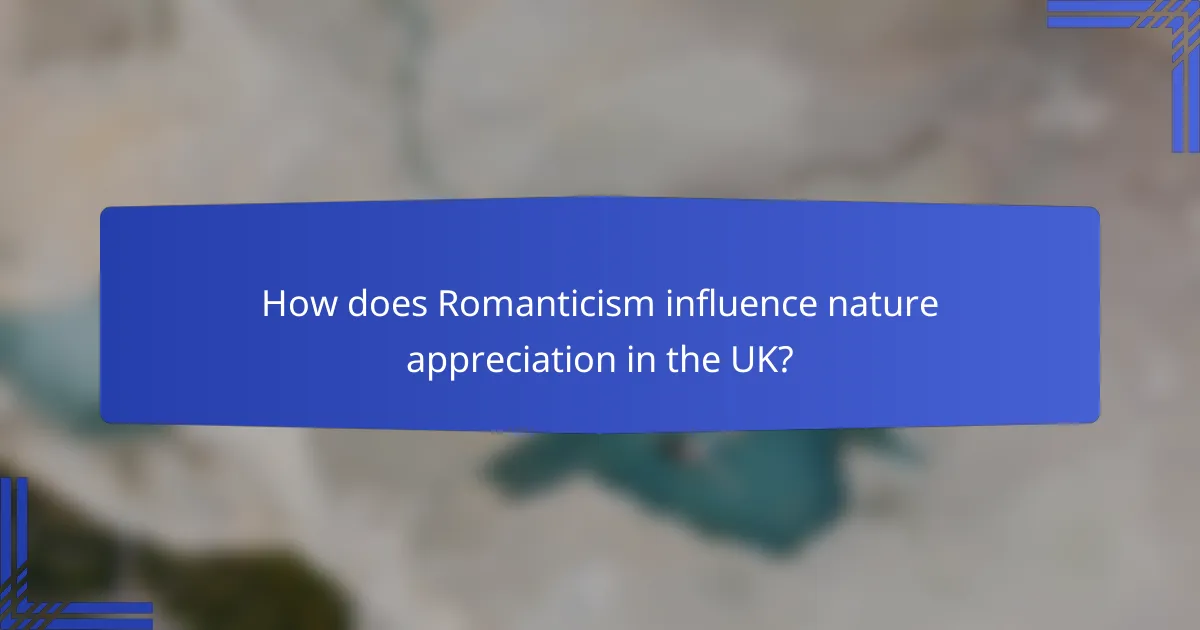
How does Romanticism influence nature appreciation in the UK?
Romanticism profoundly shaped the appreciation of nature in the UK by emphasizing emotional responses and individual experiences. This movement encouraged a deep connection to the natural world, fostering a sense of wonder and reverence for its beauty.
Emphasis on natural beauty
Romanticism highlighted the intrinsic beauty of nature, encouraging individuals to seek out and appreciate landscapes in their purest forms. Poets and artists celebrated the aesthetic qualities of mountains, rivers, and forests, often portraying them as reflections of human emotion.
This focus on natural beauty led to a cultural shift where people began to value outdoor experiences, such as hiking and exploring the countryside, as essential to personal well-being. The picturesque landscapes of the Lake District and the Scottish Highlands became iconic representations of this appreciation.
Connection to the sublime
The concept of the sublime, a key element of Romantic thought, refers to the overwhelming beauty and grandeur of nature that can evoke both awe and fear. This connection to the sublime encouraged individuals to confront their own emotions and existential thoughts while immersed in nature.
In the UK, this connection is often illustrated through literature and art that depict dramatic landscapes, such as stormy seas or towering cliffs, which provoke intense emotional responses. Such experiences allow individuals to reflect on their place within the natural world.
Impact on landscape painting
Romanticism had a significant impact on landscape painting in the UK, leading to a shift in how artists portrayed nature. Instead of focusing solely on realistic depictions, artists began to emphasize mood, emotion, and the interplay of light and shadow.
Notable artists like J.M.W. Turner and John Constable captured the essence of the British landscape, using vibrant colors and dynamic compositions to evoke feelings of nostalgia and reverence. Their works not only celebrated nature but also inspired viewers to appreciate the beauty surrounding them in their everyday lives.
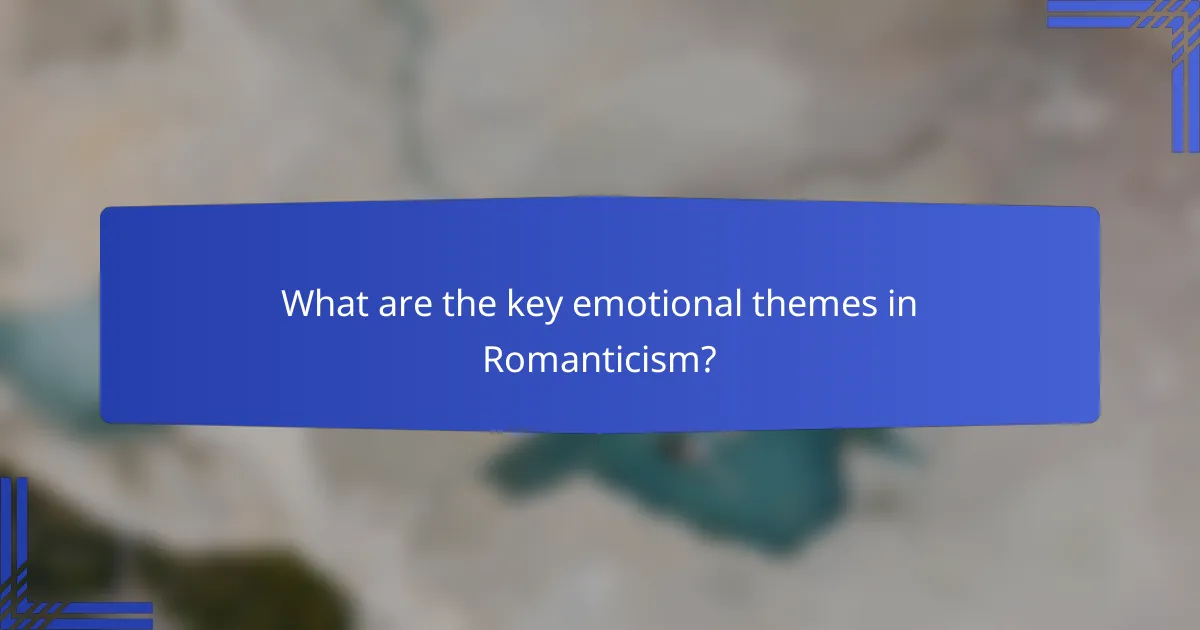
What are the key emotional themes in Romanticism?
The key emotional themes in Romanticism center around the expression of deep feelings, exploration of human experience, and the role of nostalgia. These themes emphasize the importance of individual emotion and the connection to nature, often reflecting a reaction against the rationalism of the Enlightenment.
Expression of deep feelings
Romanticism is characterized by the intense expression of emotions, often portraying love, sorrow, and passion. Artists and writers sought to convey their innermost feelings, using vivid imagery and powerful language to evoke strong responses from their audience.
This emotional depth often manifests in literature and art through the use of symbolism and metaphor, allowing creators to explore complex human emotions. For example, the works of poets like William Wordsworth and John Keats often reflect profound personal experiences and emotional truths.
Exploration of human experience
Romanticism places a strong emphasis on the individual and their unique experiences. This movement encourages a deep exploration of personal identity, often through introspective journeys and the examination of one’s place in the world.
Writers and artists frequently depicted the struggles and triumphs of ordinary people, highlighting the richness of human life. This focus on personal experience allows for a diverse range of narratives, from tales of adventure to contemplative reflections on existence.
Role of nostalgia
Nostalgia plays a significant role in Romanticism, often manifesting as a longing for the past or an idealized version of nature. This sentiment reflects a desire to reconnect with simpler times and the beauty of the natural world, which is frequently depicted as a source of inspiration and solace.
Romantic artists and writers often used nostalgic themes to critique contemporary society, suggesting that modernity had led to a disconnection from nature and authentic emotions. This longing for the past can be seen in works that celebrate rural life and the beauty of unspoiled landscapes, encouraging a return to a more harmonious existence.
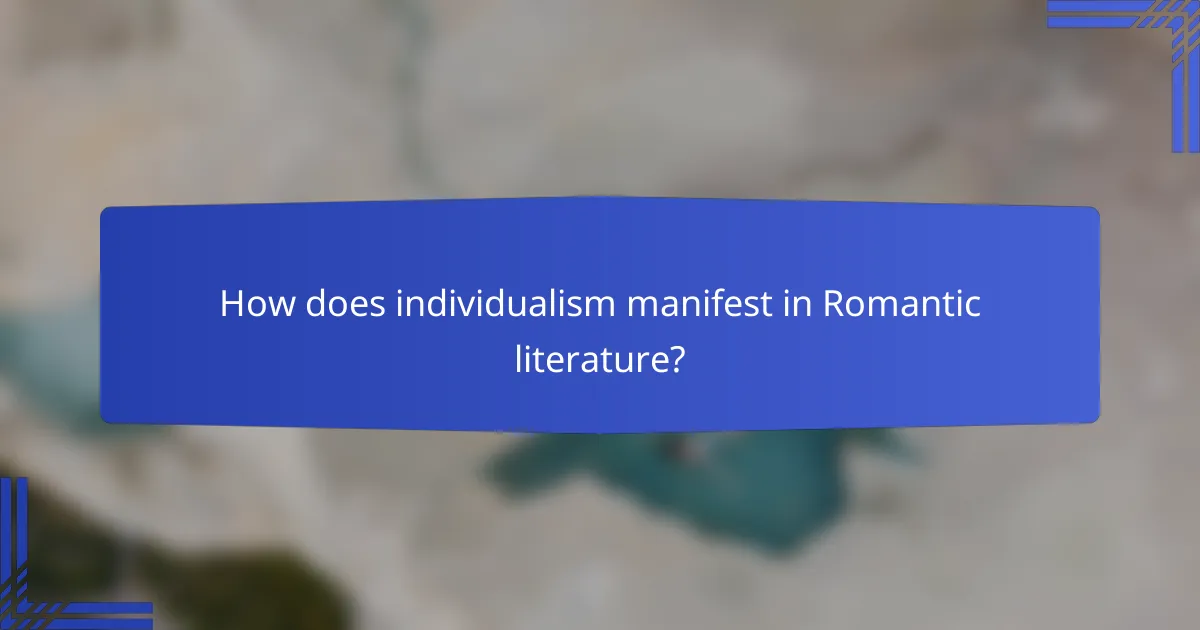
How does individualism manifest in Romantic literature?
Individualism in Romantic literature emphasizes the importance of personal identity and emotional depth, often portraying characters who prioritize their unique experiences and feelings over societal norms. This focus on the self allows for a rich exploration of human emotion and the individual’s connection to nature.
Focus on personal experience
Romantic literature often highlights personal experience as a central theme, showcasing characters who navigate their inner worlds and emotions. Authors like Wordsworth and Coleridge emphasized the significance of personal reflection and the subjective nature of reality, encouraging readers to connect with their own feelings.
This focus on personal experience allows for a diverse range of narratives, where individual perspectives shape the story. Readers are invited to empathize with characters’ journeys, making the emotional landscape of the narrative feel authentic and relatable.
Celebration of the unique self
The celebration of the unique self is a hallmark of Romantic literature, where characters often embody distinct traits and qualities that set them apart from others. This individuality is portrayed as a source of strength and creativity, encouraging readers to embrace their own uniqueness.
Writers like Emerson and Whitman championed the idea that self-expression and authenticity are vital to personal fulfillment. Their works inspire individuals to pursue their passions and trust their instincts, reinforcing the notion that each person’s journey is valuable and worthy of exploration.
Contrast with Enlightenment ideals
Romantic individualism stands in stark contrast to Enlightenment ideals, which emphasized reason, logic, and universal truths. While Enlightenment thinkers sought to understand humanity through rational thought, Romantics believed that emotion and personal experience were equally important in understanding the human condition.
This divergence is evident in the way Romantic literature often rejects the notion of a singular truth, instead celebrating the complexity of human emotion and the subjective nature of reality. By valuing intuition and personal insight, Romantic writers paved the way for a more nuanced understanding of individuality.
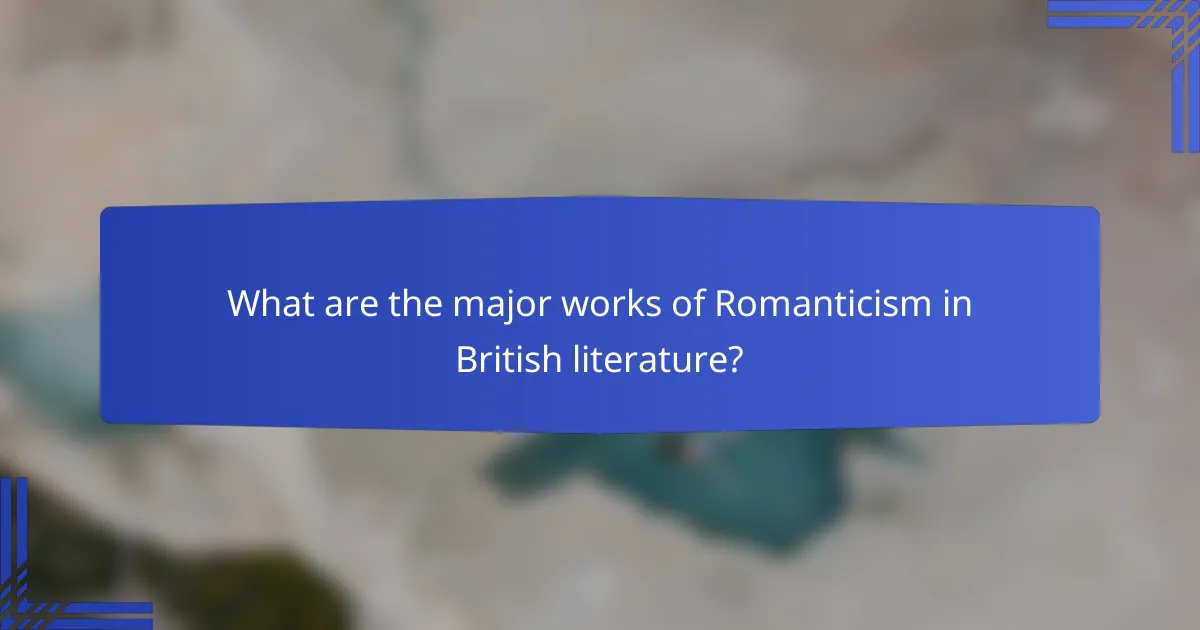
What are the major works of Romanticism in British literature?
The major works of Romanticism in British literature emphasize the importance of nature, emotion, and individualism. Key texts include “Lyrical Ballads” by Wordsworth, “Childe Harold’s Pilgrimage” by Byron, and “Ode to a Nightingale” by Keats, each showcasing the Romantic ideals through their unique styles and themes.
Wordsworth’s “Lyrical Ballads”
Published in 1798, “Lyrical Ballads” is a groundbreaking collection co-authored by William Wordsworth and Samuel Taylor Coleridge. This work marked a shift towards everyday language and themes, focusing on the beauty of nature and the depth of human emotion.
Wordsworth’s poems, particularly “Tintern Abbey,” explore the connection between nature and the human spirit. He emphasizes personal reflection and the transformative power of nature, encouraging readers to appreciate the world around them.
Byron’s “Childe Harold’s Pilgrimage”
“Childe Harold’s Pilgrimage,” published in the early 1810s, is a narrative poem that follows the journey of a disillusioned young man. Lord Byron uses this character to express themes of individualism and the quest for identity, reflecting his own experiences and emotions.
The poem combines vivid descriptions of landscapes with deep introspection, showcasing Byron’s mastery of blending personal feelings with broader social commentary. It captures the essence of Romanticism through its exploration of the sublime in nature and the complexities of the human condition.
Keats’ “Ode to a Nightingale”
John Keats’ “Ode to a Nightingale,” written in 1819, is a poignant exploration of beauty, mortality, and the power of imagination. The poem contrasts the ephemeral nature of human life with the eternal song of the nightingale, symbolizing the ideal of transcendent beauty.
Keats employs rich imagery and sensory language to evoke deep emotional responses, inviting readers to reflect on their own experiences of joy and sorrow. This work exemplifies the Romantic focus on individual emotion and the profound connection to nature.
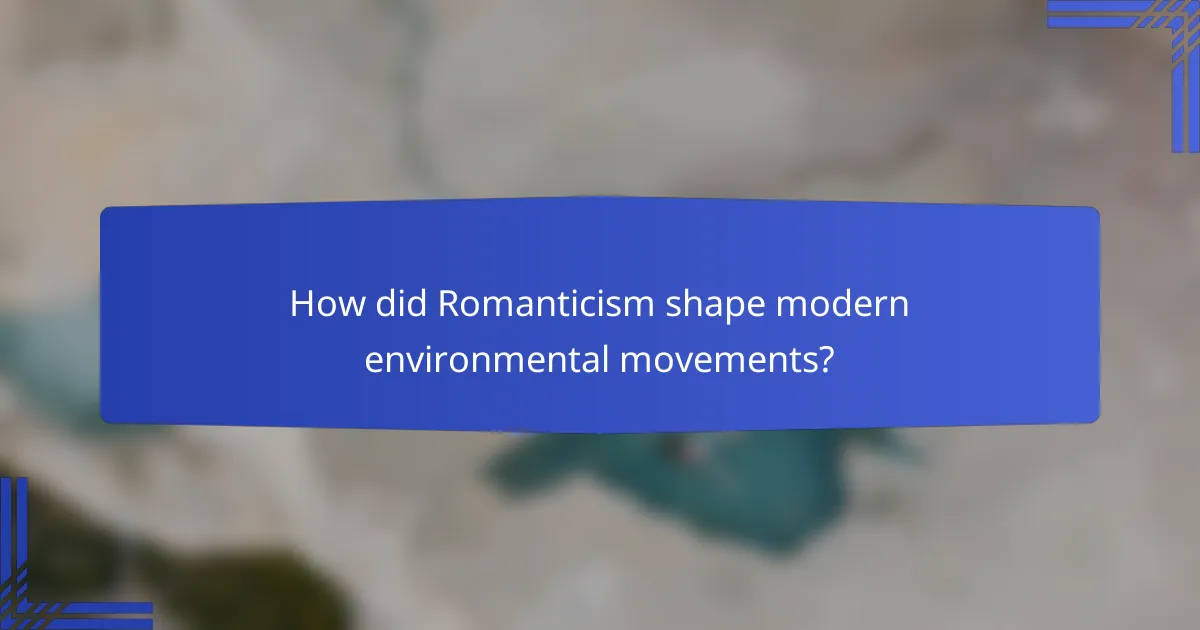
How did Romanticism shape modern environmental movements?
Romanticism significantly influenced modern environmental movements by emphasizing the intrinsic value of nature, emotional connections to the environment, and the importance of individual experience. This cultural shift fostered a deeper appreciation for the natural world, inspiring contemporary conservation efforts and sustainable practices.
Inspiration for conservation efforts
Romanticism inspired conservation efforts by highlighting the beauty and emotional significance of nature. Artists and writers of the Romantic era celebrated landscapes, which led to a growing awareness of environmental degradation and the need to protect natural spaces. This appreciation laid the groundwork for the establishment of national parks and protected areas in the 19th and 20th centuries.
Organizations like the Sierra Club, founded in the late 19th century, drew on Romantic ideals to advocate for the preservation of wilderness. Their campaigns often emphasized the spiritual and aesthetic value of nature, resonating with the public’s emotional connections to the environment.
Influence on eco-criticism
Romanticism has had a profound impact on eco-criticism, a field that examines literature and culture through an environmental lens. Romantic writers often portrayed nature as a living entity, which has encouraged eco-critics to explore the relationship between humans and the natural world in contemporary literature. This perspective challenges traditional narratives that prioritize industrial progress over ecological balance.
By analyzing texts through the lens of Romantic ideals, eco-critics highlight themes of interconnectedness and the moral responsibility to protect the environment. This approach fosters a deeper understanding of how literature can influence environmental awareness and activism today.
Connection to sustainable practices
The Romantic emphasis on individualism and emotional connections to nature has led to a greater focus on sustainable practices in modern society. Many contemporary movements advocate for practices that honor the environment, such as organic farming, permaculture, and local sourcing. These practices reflect the Romantic belief in the importance of living in harmony with nature.
Individuals and communities are increasingly adopting sustainable lifestyles that prioritize ecological balance and personal well-being. This shift is evident in the rise of eco-friendly products and initiatives aimed at reducing carbon footprints, demonstrating the lasting influence of Romantic ideals on how people engage with the environment today.

What are the characteristics of Romantic art?
Romantic art is characterized by its focus on nature, emotion, and individualism. It emphasizes personal expression and the beauty of the natural world, often featuring dramatic scenes and vivid colors.
Use of vivid colors
Romantic artists often employed vivid colors to evoke strong emotions and create a sense of drama. Bright hues and contrasting tones were used to highlight the beauty of nature and the intensity of human feelings.
For instance, landscapes might feature deep blues and vibrant greens to portray the majesty of mountains or lush forests. This use of color not only attracted viewers but also invited them to experience the emotions tied to the scene.
Emphasis on emotion and imagination
Emotion and imagination are central to Romantic art, as artists sought to express their inner feelings and subjective experiences. This movement encouraged artists to explore themes of passion, despair, and the sublime, often drawing inspiration from personal experiences and dreams.
Works from this period frequently depict dramatic narratives or intense emotional states, inviting viewers to connect with the artist’s vision. The focus on individual perception allows for a diverse range of interpretations, making each piece a unique exploration of human experience.
